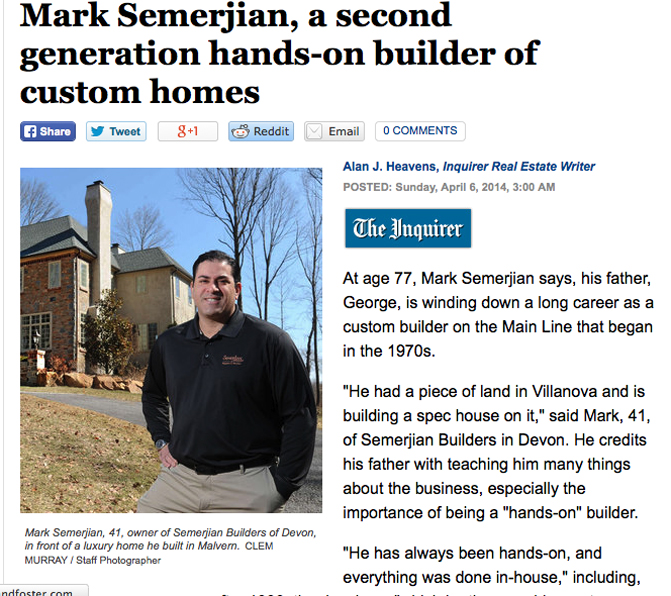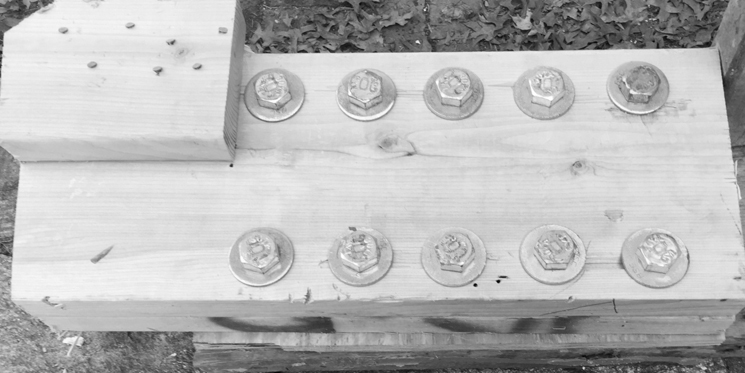At age 77, Mark Semerjian says, his father, George, is winding down a long career as a custom builder on the Main Line that began in the 1970s. “He had a piece of land in Villanova and is building a spec house on it,” said Mark, 41, of Semerjian Builders in Devon. He credits his father with teaching him many things about the business, especially the importance of being a “hands-on” builder.
“He has always been hands-on, and everything was done in-house,” including, after 1990, the drawings, “which he then would pass to a structural engineer,” the younger Semerjian said.
Mark Semerjian grew up in the business, and like many second-generation builders, he learned the job working weekends and summers, doing the grunt work.Builders fall into two categories, he said: “the guy who has money and can hire someone else to run a job, or the one who is hands-on and climbs the ladder.”
When you are involved in building anything from the concept on, Semerjian said, “you learn to be sharp and on your toes, and if any errors are made, you only have yourself to blame.” By “concept on,” Semerjian means that when a client comes to him, “I get engaged in finding the land, helping to obtain the financing and see it through.”
There is no bidding involved, he said. That way, “I really get to know the homeowner on these projects, and costs are addressed during construction.” The other part of the equation is the architect, Semerjian said: “Any qualified architect is always eager to embrace a custom-home situation and working with a qualified builder,” so it’s a win-win situation in which new ideas can easily play a role.
Custom or not, builders need to have fresh ideas and know the design and product landscape intimately, he said.
“Building has changed over the last five to 10 years,” he said, “especially in what clients expect and want. Clients expect builders to understand what they want and what they are talking about when they refer to something on the Internet.”
“They are looking for something unique to be built,” Semerjian said. And the “palette of features that are available to homeowners is endless. It is not just like buying a car and adding a few options.” Determining costs is critical, said Semerjian, who recently sold a spec home he built in Radnor for $2.5 million. “I hit the right keys,” he said. “If I hadn’t, I wouldn’t have been able to make any money.”
A custom builder in the high-end market needs to have an almost encyclopedic knowledge of every product and construction process, he said. For example: where the rebar should go in concrete.
“You need to be able to offer choices,” Semerjian said, because his clients are as concerned about spending money as everyone else. “If I can make something costing $1 look like $10, that’s what the people want. But they understand sometimes you have to spend $10 to get a $10 look.”
The goal is to build a house that looks as fresh 10 years down the road as when he built it. “That’s why when we put in millwork, we use adhesive and a two-part epoxy on the miters,” he said. “Houses move and millwork with it, and the goal is to find ways to prevent that from happening.” When he pours concrete for footings and walls, “I have a lab come up with the mixture, then show reports to the clients,” Semerjian said. Since the average person doesn’t understand “performance dynamics, I want them to know everything about the process.”
Semerjian said he is always “playing devil’s advocate” when it comes to new products, such as PVC pipe a few years back. “I hear horror stories, so I talk with the product rep, get all of the information, determine the temperature range for proper installation, and use highest-quality adhesives,” he said, before he feels confident using something.
Semerjian arranges for subcontractors and their employees to capitalize on their strengths. “Take tile, for instance. If I know someone is expert at installing mosaic tile, I’ll make sure he does that work.”
Semerjian said he doesn’t think he’ll “ever work as hard as my dad,” who still stays up till 3 a.m. working on plans.
“If I have half his dedication, I’ll be OK,” he said.



